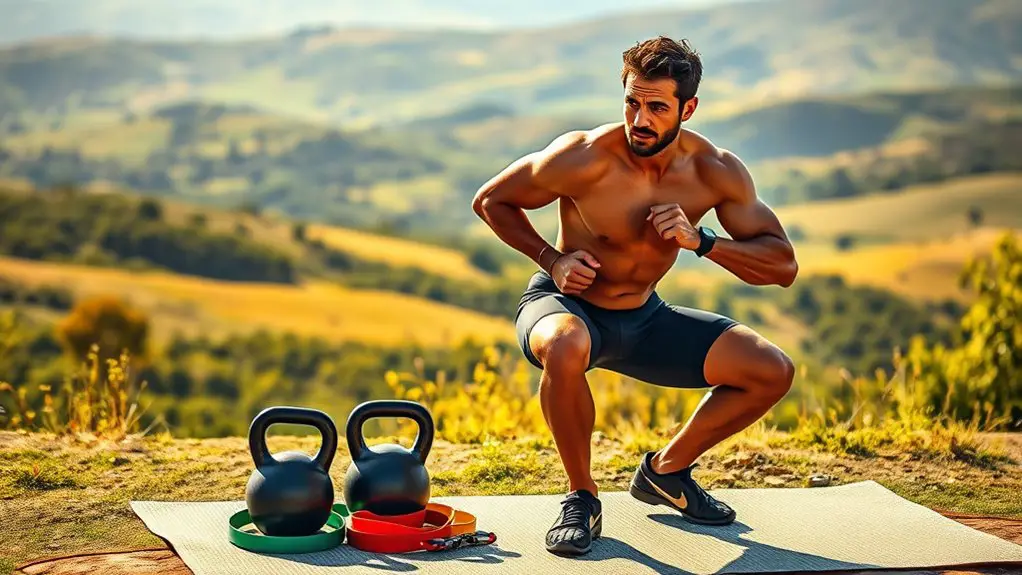To increase your functional fitness for obstacle courses, focus on enhancing strength, agility, and endurance. Incorporate bodyweight exercises like push-ups and squats for foundational strength. Add plyometrics, such as box jumps, to boost agility. For endurance, try trail running and circuit training. Don't forget to mix in mobility and balance work to prevent injuries. Consistency is key, and there's much more effective strategies to explore that can help you reach your goals.
Understanding Functional Fitness
Functional fitness is all about preparing your body for real-life movements and challenges. It's not just about lifting weights or running on a treadmill; it's about building strength, balance, and flexibility to tackle everyday tasks with ease. Think about how you move during daily activities—bending, twisting, jumping. Functional fitness trains your muscles to work together, mimicking those movements so you can feel more capable and free.
When you engage in functional training, you're not just improving your performance in obstacle courses; you're enhancing your overall quality of life. You'll find yourself more agile, whether you're climbing stairs, playing with kids, or maneuvering through nature. This approach empowers you to break free from limitations and enjoy life to the fullest. So, embrace functional fitness, and you'll discover a stronger, more resilient version of yourself, ready to take on any adventure that comes your way. Incorporating compound movements into your routine can further enhance your strength and agility.
Key Components of Functional Fitness
There are several key components to functional fitness that can considerably enhance your performance in obstacle courses and everyday activities. Understanding these elements will empower you to move freely and confidently through challenges.
| Component | Description |
|---|---|
| Mobility | Enhances your range of motion, reducing injury risk. |
| Strength | Builds muscle for lifting, climbing, and pushing. |
| Endurance | Improves stamina for prolonged physical exertion. |
| Balance | Increases stability, helping you navigate uneven surfaces. |
| Coordination | Enhances your ability to move efficiently and fluidly. |
Incorporating mobility training into your routine not only improves your range of motion but also reduces injury risk during challenging activities.
Effective Exercises for Strength and Agility
To excel in obstacle courses, you need to focus on effective exercises that enhance both strength and agility. Start with bodyweight movements like push-ups, squats, and lunges to build foundational strength. Incorporate plyometrics, such as box jumps and burpees, to boost your explosiveness and agility. Don't forget about core workouts; planks and Russian twists will help stabilize your body as you tackle obstacles.
Resistance training is key, too. Use kettlebells or dumbbells for exercises like deadlifts and overhead presses to further develop your strength. Agility ladders and cone drills can refine your footwork, making it easier to navigate challenging terrains. Additionally, including plyometric exercises in your routine can significantly enhance your overall performance and speed.
Finally, practice functional movements like climbing and crawling to mimic the real obstacles you'll face. By blending these exercises, you'll cultivate the strength and agility necessary to conquer any course while enjoying the freedom of movement.
Incorporating Cardio for Endurance
Building strength and agility is just part of preparing for obstacle courses; incorporating cardio is essential for boosting your endurance. When you're racing against time, every breath counts, and cardio training can make that difference. Here's how to embrace the freedom of movement and elevate your stamina:
- Trail running: Feel the earth beneath your feet as you navigate winding paths.
- Jump rope: Experience the rhythm that keeps your heart pumping and your feet light.
- Cycling: Hit the open road or trails, letting the wind rush past you.
- Swimming: Glide through water, using every stroke to build lung capacity and strength.
- Circuit training: Combine intervals of high-intensity exercises to mimic the unpredictability of obstacle courses. Incorporating hydration strategies during your cardio sessions can significantly enhance your performance and endurance.
Designing a Functional Fitness Training Plan
Creating a functional fitness training plan can seem intimidating, but with the right approach, it'll become a powerful tool in your obstacle course preparation. Start by identifying your specific goals, then structure your workouts around key functional movements.
Here's a simple framework to guide you:
| Day | Focus Area | Example Exercises |
|---|---|---|
| Monday | Strength | Squats, Deadlifts, Push-Ups |
| Wednesday | Agility & Balance | Box Jumps, Lateral Shuffles |
| Friday | Endurance | Running, Rowing, Circuit Training |
| Saturday | Flexibility & Recovery | Yoga, Stretching, Foam Rolling |
Incorporating a mix of strength, agility, endurance, and recovery will help you build the well-rounded fitness necessary for tackling obstacles. Additionally, focusing on improved strength and power through bodyweight exercises can significantly enhance your performance. Remember, consistency is key. Embrace this journey; it's your path to freedom in the race ahead!
Tips for Staying Motivated and Tracking Progress
Staying motivated and tracking your progress can make all the difference in your functional fitness journey for obstacle courses. To keep that fire burning and guarantee you're moving forward, try these tips:
Staying motivated and tracking your progress is essential for success in your obstacle course fitness journey.
- Set clear, achievable goals that excite you and push your limits.
- Document your workouts, noting what you've accomplished and how you felt—this helps you see your growth.
- Celebrate small victories, whether it's mastering a new obstacle or increasing your endurance.
- Find a workout buddy to share the journey with; the camaraderie can keep you engaged.
- Mix up your routine with new exercises or challenges to keep things fresh and exhilarating.
- Engage with like-minded individuals for support and encouragement as you pursue your fitness goals, which can enhance your motivation and accountability through online communities.
Frequently Asked Questions
What Equipment Is Essential for Functional Fitness Training at Home?
So, you think you can just work out without gear? Think again! You'll need dumbbells, resistance bands, a sturdy mat, and maybe a kettlebell. Your freedom to train at home deserves some essential equipment, doesn't it?
How Can I Prevent Injuries During Obstacle Course Training?
To prevent injuries during training, always warm up properly, listen to your body, and gradually increase intensity. Incorporating strength and flexibility exercises will help you stay balanced and resilient while enjoying your obstacle course adventures.
What Are Common Mistakes to Avoid in Functional Fitness Training?
When it comes to functional fitness, don't put all your eggs in one basket. Avoid overtraining, neglecting recovery, skipping form checks, and ignoring your body's signals. Listen closely, and you'll thrive in your training journey.
How Does Nutrition Impact Functional Fitness Performance?
Nutrition's essential for your functional fitness. It fuels your workouts, aids recovery, and boosts overall performance. By choosing whole foods, staying hydrated, and balancing macronutrients, you'll enhance your energy and stamina for any challenge.
Can Functional Fitness Training Benefit Older Adults?
Functional fitness training can enhance mobility, strength, and balance in older adults. It helps you maintain independence, reduces injury risk, and improves overall well-being, allowing you to enjoy life more freely and actively.




